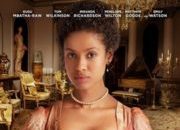
This extraordinary tale from 1789 of the daughter of a West Indian Slave and an aristocrat British Navy Captain was so far fetched that it had to be true. Like something out of the pages of a Jane Austen novel, it is the tale of Sir John Lindsay taking charge of his illegitimate daughter after the sudden death of her mother, but as he has just been commissioned to undertake a long sea voyage that could take years, he hands the scared young child over to the care of his uncle, Lord Mansfield.
Lord Mansfield who resides in glorious Kenwood House on the outskirts of London happens to be the Lord Chief Justice for England and as such is a stickler for ‘doing the right thing’. Which in this case includes the motherless child’s right to an upbringing in her ancestral home. The Mansfields are already raising a another young niece after her mother died, so Lady Mansfield agrees that Dido Belle will a suitable companion for Lady Elizabeth who is about the same age.
Whilst the Mansfield’s wholeheartedly adapt to the notion of raising this negro child as part of their family they lay down some odd ground rules so as not to offend the sensibility of any guests. Dido therefore is considered not good enough to dine with the family, but also too superior to eat with the servants, so she takes her meals on her own when Company visits.
Meanwhile the penniless son of the local Church Minister who has become Lord Mansfield’s legal pupil stirs a passion in Dido for the difficult case the Chief Justice must rule on, and also for his own heart too. The infamous case involves the cold-hearted murder of a cargo of slaves being transported from the Colonies and much to the wrath of Lord Mansfield, Dido sides with John Daviner as they are both desperate to insure that the Ruling goes in the slaves favor.
In the course of the two young ladies growing up Lord Mansfield commissions an artist to paint their portrait to be hung in the family gallery. It’s this picture that controversially shows the two girls as social equals that exists in real life (and was hanging in Kenwood up till 1922) that is the basis of the story that this movie was built upon. That, and the fact that Sir (later Admiral) John Lindsay did in fact have his half-negro child brought up by the Mansfields is on the record …. as to is the Zong Case on which Lord Mansfield’s ruling help signal the early death knoll for slavery in the UK. However the rest of it, including Dido rejecting her aristocrat fiance to marry the poor man she loved is the work of the vivid imagination of screenwriter Misan Sagay and director Amma Asante.
This very charming period costume has a deeper message than most of this genre with the heads on way it tackles racism in 18th Century Britain and its political content of something a great deal weightier than usual. Asante made the whole concept of having a black member of an landed aristocratic family very convincingly real no matter how bizarre it seemed at first. She was helped too by the fact that Dido was played so superbly by the stunningly beautiful Gugu Mbatha-Raw, a actress who has up to now worked mainly British TV. The Mansfields were competently played by Tom Wilkinson and Emily Watson, and Sam Reid put in a good performance as John Davenier. The two stand out performances besides there were the irrepressible Miranda Richardson perfectly hilarious as the two faced pushy Lady Ashford, and Penelope Wilton (Downtown Abbey) as old Aunt Mary who’s ultra-dry wit had all the best put downs in the film.
Beautifully to look at with its very lush sets …. and Kenwood House itself …. this is the stylish stuff that Brits still excel at, and the added edge to this story made it just that more entertaining .


